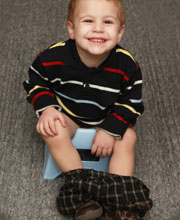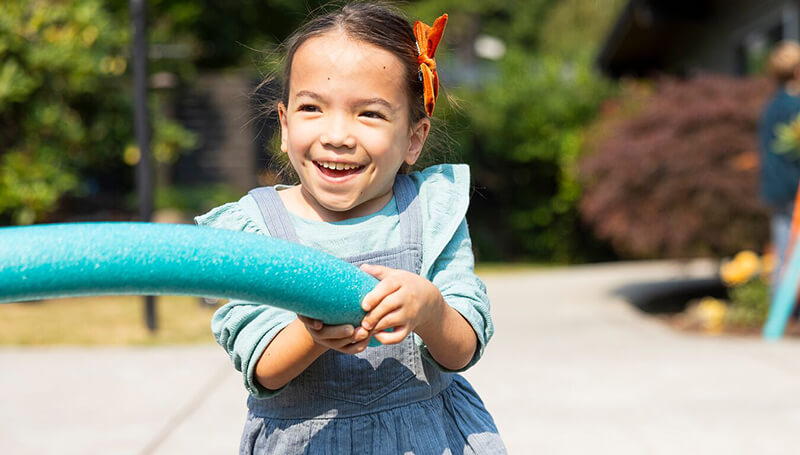Potty Training Your Child
You can download this article as a PDF (English, Spanish).
How do I know my child is ready?
 A child’s body and mind need to be ready to learn to use the toilet. Babies cannot control the muscles that keep their bladder and rectum closed until about 18 months. Before this time, if you put your baby on the toilet, your child may pee (urinate), but they cannot control when they go or hold their urge to pee.
A child’s body and mind need to be ready to learn to use the toilet. Babies cannot control the muscles that keep their bladder and rectum closed until about 18 months. Before this time, if you put your baby on the toilet, your child may pee (urinate), but they cannot control when they go or hold their urge to pee.
Most children begin to show that they are ready to toilet train between 18 and 24 months. Some may be ready sooner and some later. Watch your child for these signs that tell you they are ready. Does your child:
- Tell you when they need to go or have gone to the bathroom?
- Pull down their diaper, training pants or underwear on their own?
- Follow simple instructions such as “please bring me the book”?
- Understand words about going to the bathroom?
- Have bowel movements that are regular and occur about the same time?
- Have a dry diaper for 2 or more hours?
- Know how to get to the toilet, sit on it and get off?
- Show interest in using the toilet or wearing underwear?
Let your child be the guide in when to start. Don’t let friends, parents, in-laws or child care providers pressure you to begin training your child.
How can I help my child get ready?
There are things you can do to prepare your child before they are ready to toilet train. This will help your child connect the feeling of fullness and the need to go to the potty.
- Help your child to learn when they are peeing and pooping (having a bowel movement). They may stop playing, grunt, squat, hide or pull at their diaper. Ask them, “Are you going poop?” Use words like pee, poop and potty to help your child learn what their body is doing.
- Ask your child to let you know when their diaper is wet or when they have gone poop.
- Avoid making faces or using words like messy, yuck, or dirty when changing your child’s diaper.
What kind of potty should I use?
There are two basic types of potty seats. The first is a stand-alone potty that your child sits on. These come with a bowl that you can empty into the toilet. The second type is a seat that fits on top of your toilet seat. These help your child fit onto the seat and help them feel safe. If you use this type of seat, provide a step-stool that your child can use to rest their feet on to help them relax and to push when they have a bowel movement.
You may want to have more than one potty seat. Put one in each bathroom and keep one in your car for emergencies.
How can I encourage my child to use the potty?
- Let your child practice sitting on the potty chair. They can start sitting on it with their clothes on, then their diaper and eventually bare-bottomed.
- Don’t make your child sit on the potty when they don’t want to.
- Show your child how you sit on the toilet. Your child will learn by watching you or an older sibling.
How can I make it comfortable for my child?
It is important for your child to relax when going to the bathroom.
- Remove your child’s pants or tights so they have room to spread their legs open.
- Put your child on the potty chair or toilet seat so that their bottom is securely in the toilet opening.
- Have your child put their elbows on their knees and lean forward. This helps the pelvic muscles relax.
- Give your child time. It can take 3 to 5 minutes to empty the bladder.
Tips for Success
- Help your child to go to the bathroom every 2 to 3 hours to help prevent urgent and stressful trips to the toilet. Make going to the potty part of your daily routine, such as when your child wakes up, after meals or before nap time.
- Have all your child’s caregivers, including grandparents and babysitters, follow the same routine.
- Have your child use the potty 15 to 30 minutes after meals. The body has a natural reflex to go poop after eating.
- It is best to teach boys to pee sitting down at first. Put cereal pieces in the toilet for your son to aim at when learning how to pee standing up.
- Accidents will happen. It is important not to punish your child or act disappointed. Let your child know that this can sometimes happen when you are learning.
- Keep special potty time books or toys in the bathroom for your child to look at or play with.
- Dress your child in simple-to-use clothing while they are learning. Choose easy-to-pull-down pants, and avoid shirts that snap at the crotch.
- Praise your child for sitting on the potty, even when nothing happens!
- Some children respond well to small rewards when they use the potty. You can use stickers or made-up coupons for extra reading time or music time. Once your child seems to be using the toilet with success, let them pick out new big-kid underwear.
- If your family is going through a stressful time, such as a recent move, traveling, sickness or the birth or adoption of a new baby, it may be best to delay toilet training until things are settled.
What can I do if we travel?
Pack a potty chair or seat in your car. Stop every 1 to 2 hours for your child to use the potty. If you wait until your child has to go, you may have to spend time looking for a place and not have enough time.
What about training pants?
When your child starts being able to use the potty, you may want to use training pants. Going to get training pants can be a special event to celebrate with your child.
How long can it take for my child to toilet train?
You may see or read about programs that are for babies or promise toilet training in a quick time. While these may work for some people, the steps we’ve offered have stood the test of time. Toddlers often learn to use the toilet in 3 to 6 months. Some children may need more or less time.
When will my child stay dry at night?
Most children get control of their bladders during the day when they are between 2 and 5 years old. It may be months or years before your child can stay dry at night. Most children are able to stay dry at night after 5 years of age. Talk to your child’s doctor if you have any questions about toilet training.

